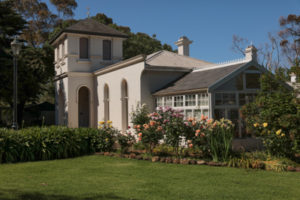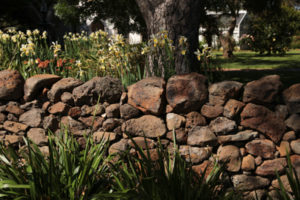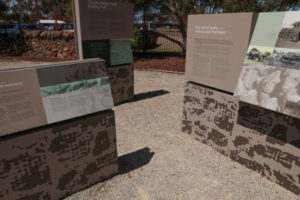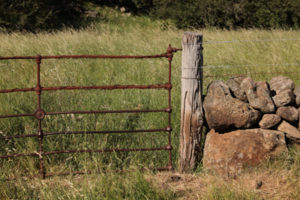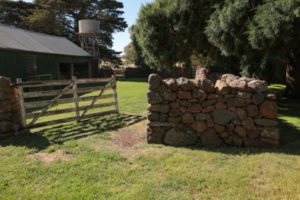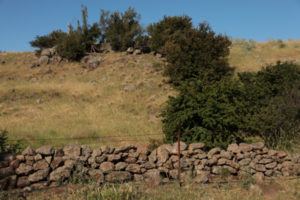- Mt Cotterell
- Wall at foot of Mt Cotterell, repaired by volunteer workshops
- Pinewood
- Pinewood
The outer-metropolitan municipality of Melton, on the broad volcanic plains that stretch from Melbourne to Mt Gambier, is undergoing rapid transformation as new homes and roads replace sheep paddocks. The natural landscape is the aftermath of seven extinct volcanoes whose low cones dot the terrain and whose rocks dot the paddocks. Early settlers carved up the land and used the plentiful stone as property boundaries and paddock walls.
Melton’s dry stone walls are not the most pristine or the largest, longest or highest, but they do include a composite style of a low double wall, about 600mm high, with timber posts set within the wall and extending up wards to carry a timber rail or several strands of wire. There are few walls of this style elsewhere in Australia or, to our knowledge, overseas.
- Heritage display at The Willows Historical Park
- The ‘sculpture’ wall at the Willows
Melton Council officers welcomed our group of 25 members and friends at ‘The Willows’, a historic park in the centre of Melton. Under the guidance of Sera Jane Peters, the municipality’s heritage advisor and keen advocate for its dry stone walls and structures, we set off on a tour that took us first to the top of Mt Cottrell, soon to be part of a vast new linear park notable for its native grasslands, for a view over the plains to the towers of central Melbourne, then past examples of roadside walls in varying states of repair. Unfortunately urbanisation, pilfering and neglect are causing the loss of these defining elements of the landscape. Melton does, however, protect some walls in a number of precincts, through its planning scheme, and assists owners of those walls to maintain them.
At ‘Pinewood’, a large historic property centred on a fine bluestone homestead located in the rolling hills of Toolern Vale, the group enjoyed afternoon tea in the glass-walled conservatory among the roses and the shady lawns, then wandered the property inspecting its variety of walls and other features of a Victorian-era sheep and horse property.
Dinner was arranged at Galli restaurant and winery, with the lively chatter broken by an excellent talk by Colleen Lazenby, heritage co-ordinator at the City of Whittlesea. Whittlesea is another outer metro area where the local Council is placing great importance on the survey and protection of its legacy of dry stone walls, and is using an innovative process of aerial photography and in-field surveys to create a comprehensive database for the on-going management of this recognised and valued asset. We will work with Whittlesea to encourage other municipalities to use a similar methodology in their areas.
About the City of Melton
The City of Melton is a very significant local government leader on heritage and in particular, protecting the dry stone walls in their fast-growing municipality on the vast volcanic plains to Melbourne’s west.
The council began in almost a decade ago by commissioning comprehensive study of their walls – work that was crucial to what is now a very effective strategy for their enhancement and appreciation. See here for more detail on this.
Melton has since:
- included 125 dry stone walls in its Heritage Overlay and policy
- conducted four workshops and trained over 100 participants in walling repair
- repaired over 100 meters of Council-owned walls
See here for their Heritage Strategy 2017-21. As a result of this and their Dry Stone Wall Driving Trail, see here, dry stone walls are loved and recognised widely as a defining and significant feature of the landscape.
‘Pinewood’
Pinewood (Toolern Vale) is significant as a predominantly intact nineteenth century farm complex associated with the pioneer pastoralist John Beaty, son John and descendents. The 1876 bluestone homestead is a predominantly intact example of a Victorian style and one of few surviving Victorian styled homesteads constructed in bluestone in the Melton Shire. The property also contains some notable plantings, including old Pinus radiata, hawthorn plantings and an old pear tree, and in particular a very old ‘Canary Island Pine’ tree.
The homestead demonstrates original design qualities of a Victorian style including the symmetrical composition, single storey height, hipped roof form clad in slate tiles and the rendered chimneys. Other intact or appropriate qualities include the bluestone wall construction, location of the return verandah, narrow eaves, central timber framed main doorway with highlight and the flanking timber framed double hung windows.
The extensive system of substantial and largely intact drystone paddock walls are aesthetically, historically and scientifically significant at a local level. They demonstrate an unusual and now rare form of nineteenth century fence construction, and contribute to an impressive and intact early farming cultural landscape.
Source: Shire of Melton Heritage Study – volume 3


